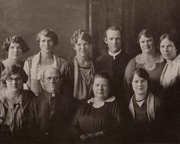Snapshot of present "kings of the Medes"
If the war between Iraq and Kurdistan is on the horizon, then the rising of "kings" -- rulers, national leaders -- of the "Medes" -- the Kurds -- who are in power at that time must also be imminent. As mentioned in the last post, a prominent Kurdish leader, Jalal Talabani, currently holds not only his long-standing position as Secretary General of the Patriotic Union of Kurdistan (PUK), a "democratic resistence movement" struggling to "realize Kurdish... aspirations" against Iranian oppression, he is also the President of the new Iraqi government formed by the recent elections held under coalition occupation. This position however, in the parliamentary form of government, is mostly ceremonial in nature. Talabani's real power lies in his comand of the PUK militia forces which secure the southeastern Kurdish region situated closest to Baghdad.

"Uncle Jalal" Talabani
But Talabani's PUK is not the only Kurdish rebel organization operating in northern Iraq. An even more dominant force has been the rival Kurdistan Democratic Party (KDP) under the leadership of Masoud (Massoud) Barzani, son of the revered Kurdish rebel leader the late General Mullah Mustafa Barzani.

Masoud Barzani has led the KDP for decades
In 1998, Talabani and Barzani stopped their in-fighting and signed a peace agreement sponsored by the U.S. In 2002 they further joined forces, later supporting the coalition invasion.

Kurds depict the two leaders over the Kurdish flag
According to the BBC, the KDP under Barzani commands "tens of thousands of armed militia fighters", known as the Peshmerga, which word means "ready to die." Nearly 80,000 Peshmerga fighters were armed by the U.S. in early 2003, according to the Kurdistan Observer.

Peshmerga milita members
The greatest achievement of Masoud Barzani so far, however, has been his elevation to the position as President of the autonomous Kurdistan Regional Government in Iraq. While his nephew, Nechirvan Barzani, runs the government as Prime Minister, it is Masoud who receives visitors such as U.S. Secretary of State Condoleezza Rice.
 Secretary of State Condoleezza Rice meets with Barzani
Secretary of State Condoleezza Rice meets with Barzani
There remains one faction of Kurds, the largest segment in fact, yet to be mentioned: the Turkish Kurds. While the PUK under Talabani and the KDP under Barzani fought alternately both for and against Iran and Iraq, and have now consolidated and are expanding their authority over the Iraqi portion of Kurdistan, including over Kirkuk's oil wealth, a conflict continues to rage on the Turkish border between Ankara's military and a rebel Kurdish group, the Workers Party of Kurdistan (PKK), once led by the now-imprisoned Marxist, Abdullah Ocalan.
I will explore this fascinating conflict that may soon reveal the king of the Medes of the "kingdom of Ararat" in the next blog post.
If the war between Iraq and Kurdistan is on the horizon, then the rising of "kings" -- rulers, national leaders -- of the "Medes" -- the Kurds -- who are in power at that time must also be imminent. As mentioned in the last post, a prominent Kurdish leader, Jalal Talabani, currently holds not only his long-standing position as Secretary General of the Patriotic Union of Kurdistan (PUK), a "democratic resistence movement" struggling to "realize Kurdish... aspirations" against Iranian oppression, he is also the President of the new Iraqi government formed by the recent elections held under coalition occupation. This position however, in the parliamentary form of government, is mostly ceremonial in nature. Talabani's real power lies in his comand of the PUK militia forces which secure the southeastern Kurdish region situated closest to Baghdad.

"Uncle Jalal" Talabani
But Talabani's PUK is not the only Kurdish rebel organization operating in northern Iraq. An even more dominant force has been the rival Kurdistan Democratic Party (KDP) under the leadership of Masoud (Massoud) Barzani, son of the revered Kurdish rebel leader the late General Mullah Mustafa Barzani.

Masoud Barzani has led the KDP for decades
In 1998, Talabani and Barzani stopped their in-fighting and signed a peace agreement sponsored by the U.S. In 2002 they further joined forces, later supporting the coalition invasion.

Kurds depict the two leaders over the Kurdish flag
According to the BBC, the KDP under Barzani commands "tens of thousands of armed militia fighters", known as the Peshmerga, which word means "ready to die." Nearly 80,000 Peshmerga fighters were armed by the U.S. in early 2003, according to the Kurdistan Observer.

Peshmerga milita members
The greatest achievement of Masoud Barzani so far, however, has been his elevation to the position as President of the autonomous Kurdistan Regional Government in Iraq. While his nephew, Nechirvan Barzani, runs the government as Prime Minister, it is Masoud who receives visitors such as U.S. Secretary of State Condoleezza Rice.
 Secretary of State Condoleezza Rice meets with Barzani
Secretary of State Condoleezza Rice meets with BarzaniThere remains one faction of Kurds, the largest segment in fact, yet to be mentioned: the Turkish Kurds. While the PUK under Talabani and the KDP under Barzani fought alternately both for and against Iran and Iraq, and have now consolidated and are expanding their authority over the Iraqi portion of Kurdistan, including over Kirkuk's oil wealth, a conflict continues to rage on the Turkish border between Ankara's military and a rebel Kurdish group, the Workers Party of Kurdistan (PKK), once led by the now-imprisoned Marxist, Abdullah Ocalan.
I will explore this fascinating conflict that may soon reveal the king of the Medes of the "kingdom of Ararat" in the next blog post.
Labels: Judgment 6 - Civil War, Kings of the Medes



0 Comments:
Post a Comment
Subscribe to Post Comments [Atom]
<< Home